Building Our Ark
Part 4:
Electricity on the Go - Charging our Batteries
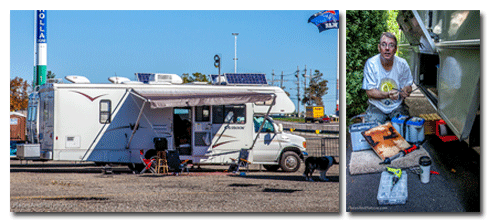
Living at home, you have regular 120 volt house power which runs your computers and TV and lights etc. In a basic RV, everything is 12 volt from car batteries. We knew from experience that regular RV power just wouldn't be adequate for our full time RV lifestyle, so we started researching and building...
We knew we wanted house power ALL the time, so we had to get extra car batteries and a BIG inverter. One SMALL inverter you might know is the gizmo that you plug into your cigarette lighter that has a regular 120 volt outlet on it so you can plug in your phone or laptop charger. In our case, we needed the biggest one we could get to convert the 12V power from the SIX combined car batteries we had room for into 120V house power connected to every plug in the camper.
Naturally, the batteries need to stay charged as much as possible to produce consistent house power through the inverter.
It’s All About the Batteries:
When driving, the engine alternator charges the batteries.
When just parked, anywhere in daylight, the Solar Panels do it.
When plugged in or running the generator, the battery charger in the RV power panel charges the batteries.
Otherwise, say, being parked unplugged overnight in the rain, the batteries create the 120V house power and slowly run down until another charging source is available - like just driving off in the morning or even the sun shining again!
Now here’s the limitation. Although we end up getting 120 volt house power from the batteries through the inverter, we don’t get the huge amperage needed to run big motors or heating elements like the air conditioner, the microwave or a portable heater. But we DO have plenty of power to run all our TVs, device chargers, RV stuff, computers, lights and fans for a very long time - indefinitely if the sun is shining on the solar panels.
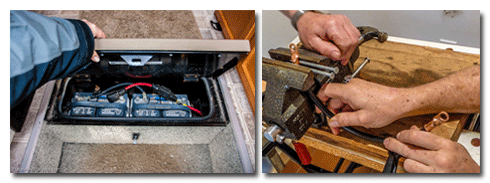 |
The original Camper Batteries; Creating CUSTOM Battery Cables |
What we Did: First, Beef up the Engine Alternator
Since the thing that makes 12 volt electricity when the engine is running is the engine alternator, it is crucial that it be up to the task of feeding our big inverter to produce house power when we are driving. The original alternator was not designed for our now-constant electrical demand for charging the extra batteries and powering the new inverter, as well as powering the new Leveling Hydraulics and the room slide-outs on top of the standard camper 12 volt system! We decided to go directly to Ford and bite the bullet on a heavier one - to the tune of $750 installed. We have never regretted it.
Protecting the Computers from Switching Power Sources: A UPS (Uninterruptible Power Supply) is a Must-Have
Since we were going to be switching around constantly between different power sources, experiencing outages as extension cords and plugs were tripped over, and loss of power switching from one power source to another when either became unavailable, we needed to shield the computers and data storage devices from all those spikes and drops in power.
The answer was to add an office device called an Uninterruptible Power Supply (UPS) to the circuit that all the computer equipment was plugged into in the back workroom. There was the added benefit that it also displayed what a variety of voltages we were receiving from shore power! If the incoming power ever dropped below 110 volts, the computers would begin to malfunction - like having errors on the hard drive storage which could be irrevocable. Who knew there was such a variety of voltage when you plug in around the country?

A UPS consists of an internal high performance 120v battery that stays charged all the time from whatever house outlet it is plugged into. We plug our computers, peripherals and hard drives into it via power strips along the countertop, and the source power is constantly passed through the UPS battery circuit. Anytime the regular house power fails, the UPS battery still supplies the 120 Volt electric load for everything plugged into it, but starts to run down, and sounds alarms.
When we hear that alarm, we scramble to find the blown circuit or problem outside, or shut down the computers quickly if it is not immediately fixable. It has been a crucial and successful addition to support our computer driven life.
The Bank of Batteries
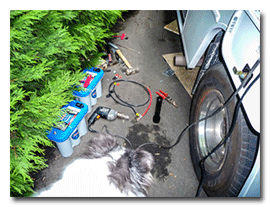 I had read that the best source was an array of 6 volt wet cell batteries, however, knowing our plan of moving a great deal, the need to check for leaks and refill evaporated water in cells was prone to disaster - plus explosive fumes were a real possibility... I took the opposite approach with (expensive) sealed, 12 volt high power batteries - and it has been quite adequate - only one has failed in five years.
I had read that the best source was an array of 6 volt wet cell batteries, however, knowing our plan of moving a great deal, the need to check for leaks and refill evaporated water in cells was prone to disaster - plus explosive fumes were a real possibility... I took the opposite approach with (expensive) sealed, 12 volt high power batteries - and it has been quite adequate - only one has failed in five years.
Wiring together two in the coach step with four more I put in the 1st storage compartment aft of the step was the most efficient. I lined the bottom of the compartment with plywood to catch any leaks and used battery trays to keep them from sliding. I ran a couple of metal straps underneath the whole compartment to help hold the extra battery weight.
The only maintenance needed with sealed batteries is to occasionally tighten the wires to each one.
The 3000 Watt Inverter
Now that we had enough batteries to produce a long stream of 12V power, we needed to convert it into normal 120V house power to use it. Enter the inverter. The SIZE of the inverter in watts tells you how much electric demand it can handle at a time - assuming enough 12V source power is there to feed it...

Now, where to put this equipment became obvious since the power panel with the fuses and battery charger was on the floor under the refrigerator with plenty of room for the inverter behind it plus the refrigerator vent gave wiring access to the roof. The two standard coach batteries were in the door well beside the refrigerator wired to the power panel, and there was an available outside storage compartment just behind the rear wheel to house the other batteries. I just had to remove the drawer under the fridge and drill a big hole for the battery cables to come in from below and attach them to the inverter.
Grounding was an issue with the inverter. At first it kept overloading and blowing its fuse. You see, there is no third prong ground wire in a camper on the move - no metal stake driven into the ground... but there is when you are plugged into a campground. So wiring the mobile 120v system is conceptually tricky. After adjusting it a number of times, I ended up having a great mechanic in Sante Fe troubleshoot and correct my wiring. MUCH better!
I mounted the control pads for both the inverter and the solar array together on the door well wall next to the power panel - convenient since they are turned on and off together depending on whether we are unplugged or not. The inverter display shows the amount of battery power left and the house power demand being satisfied and whether either is critically low or high. That way we know when to shut down the house power from the inverter (like when we go to sleep) and wait for the next time we can start recharging to turn it back on.
With 2 house power sources (shore power or inverter), the next trick was to wire both the inverter power output and the shore power output into a switch that was in turn wired into the power supply fuse panel to power all the electric outlets in the RV.
The Automatic Switchover Box
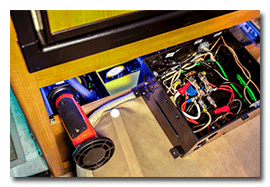 Turns out there is a gizmo. A Switch that automatically selects our house power source to be full shore power instead of our battery powered inverter only if and when it becomes available (either when you turn on the generator or plug in somewhere.) It’s pretty kool. There are springs and a big electromagnet that activates when shore power is on.
Turns out there is a gizmo. A Switch that automatically selects our house power source to be full shore power instead of our battery powered inverter only if and when it becomes available (either when you turn on the generator or plug in somewhere.) It’s pretty kool. There are springs and a big electromagnet that activates when shore power is on.
Sounds simple right? The big exception: When on inverter power, we didn’t want to power the dual gas/electric refrigerator. That would drain our batteries quickly. Unless on full shore power, we wanted the refrigerator to continue to run on propane. That meant isolating the circuit wire that fed A/C electricity to the refrigerator and ONLY wire that into the side of the switch used if shore power kicked in...
While we were at it, I wired a new outlet up near the driver so we could plug in our devices while on the move. Yeah, all this was tricky and required care but was totally worth it. Just take it one wire at a time.
Mounting the Solar Panels
OK, now that the batteries were the source of our electricity on the go, we wanted to have them fully charged, even when we were just parked - i.e. no engine or generator running. The answer was solar panels. Lots of roof space, lots of sun, we had the budget so why not?
After searching the Internet and reading as much as I could stand, I basically got the impression that the higher voltage panels produced a more useable current from the sun. I arrived at a Solar distributor named AM Solar in Oregon who offered a full customizable, do-it-yourself kit expandable to as many panels as we could handle. There was probably room for eight but at $600 each, we decided to try four. The whole setup cost about $3500 and best of all, was very well documented and supported. I would definitely recommend AMSolar.com.
When everything arrived, I was surprised a solar panel was so simple - just 2 wires coming out of the back. I hooked up a volt meter, turned the panel to the sun and like magic there was electric current! True, that’s what I was expecting but the neanderthal part of my brain was deeply convinced it was black magic...
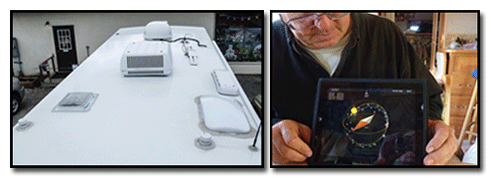
I was worried about drilling into the roof, but it turned out that the brackets that hold each panel could glue to our smooth fiberglass roof! These brackets also came with an extender bar that you could, if the sun were not passing directly overhead, angle the panels to catch the most sun. Turning the panels directly into the sun almost doubles the current they can produce at an angle, so if you are going to be boon docking for awhile, it is worth adjusting the panels for maximum sunlight. I found an App that showed the exact arc of the sun from wherever you are. That made it SO much easier.
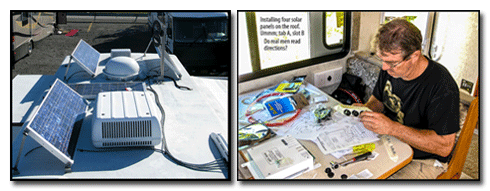
One panel is about 2’x5’ and a wire from each runs down through the refrigerator vent shaft to a control box that regulates the battery charging so that optimal battery performance and life results. As more demand is put on the system, more juice for charging is applied. If we are in sunlight, and using everything, our batteries still don’t run down. The 12V input to the inverter just stays at peak power. After five years, we haven’t added more panels, so that tells the story.
The End Result is Electricity on the Go
Wherever we are, whatever the conditions, we have our TVs available, our in-motion Satellite dish and DVR recording our shows, our cellular booster and our internal network giving us full connectivity. We have all our device and battery chargers working, both computers and all their peripherals working on house power and sharing files over the network ALL THE TIME. In addition, our 12 volt devices like vent fans and lights and furnace fans and water pumps all work like they are supercharged with the extra 12 volt power from all the batteries.
It’s more like camping in the living room than across the country.
I flip my switch/presto LIGHTS.
Tony
So awesome and inspiring! Thanks for sharing!
Todd

